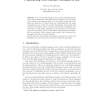Free Online Productivity Tools
i2Speak
i2Symbol
i2OCR
iTex2Img
iWeb2Print
iWeb2Shot
i2Type
iPdf2Split
iPdf2Merge
i2Bopomofo
i2Arabic
i2Style
i2Image
i2PDF
iLatex2Rtf
Sci2ools
WFLP
2009
Springer
2009
Springer
Programming with Multiple Paradigms in Lua
Abstract. Lua is a scripting language used in many industrial applications, with an emphasis on embedded systems and games. Two key points in the design of the language that led to its widely adoption are flexibility and small size. To achieve these two conflicting goals, the design emphasizes the use of few but powerful mechanisms, such as first-class functions, associative arrays, coroutines, and reflexive capabilities. As a consequence of this design, although Lua is primarily a procedural language, it is frequently used in several different programming paradigms, such as functional, object-oriented, goal-oriented, and concurrent programming, and also for data description. In this paper we discuss what mechanisms Lua features to achieve its flexibility and how programmers use them for different paradigms.
Algorithms | Different Programming Paradigms | Mechanisms Lua Features | Scripting Language | WFLP 2009 |
| Added | 25 May 2010 |
| Updated | 25 May 2010 |
| Type | Conference |
| Year | 2009 |
| Where | WFLP |
| Authors | Roberto Ierusalimschy |
Comments (0)

